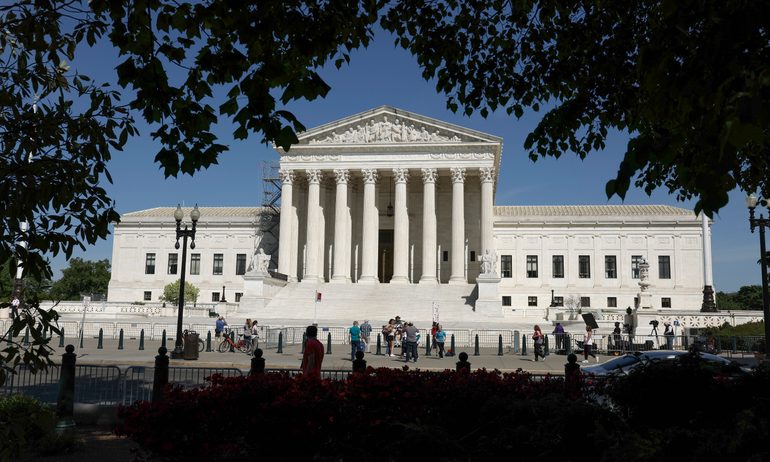Supreme Court Rejects Challenge to Abortion Pill
The high court is hearing oral arguments in a case that could limit access to medication abortion.

Many, or all, of the products featured on this page are from our advertising partners who compensate us when you take certain actions on our website or click to take an action on their website. However, this does not influence our evaluations. Our opinions are our own. Here is a list of our partners and here's how we make money.
Updated June 13, 2024:
On June 13, the Supreme Court rejected a challenge to the Food and Drug Administration’s approval of mifepristone, which is commonly known as the abortion pill and used frequently in medication abortions in the U.S., ruling that the plaintiffs lacked standing to bring the challenge. The court’s rejection of the lawsuit, FDA v. Alliance for Hippocratic Medicine, upheld access to mifepristone, which remains available through the mail to patients without having to first see a doctor.
Attempts to restrict access to the abortion pill likely aren’t over. The Court’s unanimous decision, written by Justice Brett Kavanaugh, said health care providers are protected by federal “conscience protections” from prescribing mifepristone, as well as treating mifepristone-related complications, but that the plaintiffs didn’t provide sufficient evidence that such protections were being violated.
On March 26, the Supreme Court heard oral arguments in a case that will decide the fate of an abortion pill and have ripple effects for reproductive rights in the U.S.
The drug in question, mifepristone, is one of two pills in the regimen used most commonly in medication abortions in the U.S., according to KFF, a health policy resource organization. Mifepristone blocks progesterone, a hormone that’s necessary for a pregnancy to develop, preventing an existing pregnancy from moving forward.
The case, FDA v. Alliance for Hippocratic Medicine, is seeking to limit access to mifepristone, a Food and Drug Administration-approved medication. The high court is expected to hand down a decision in June.
The mifepristone case is the most significant abortion-related case the Supreme Court has taken on since June 2022 in Dobbs v. Jackson Women’s Health Organization. The Dobbs ruling overturned the roughly 50-year-old landmark decision that provided constitutional rights to an abortion.
Medication abortion use has increased significantly in the past few years — particularly after the Dobbs decision, according to data released March 19 by the Guttmacher Institute, an abortion rights research group that tracks abortions in the U.S. In 2020, medication abortion made up 53% of all abortions, and in 2023 it was 63%, Guttmacher data shows.
How did the mifepristone case make it to the Supreme Court?
In 2000, the FDA first approved mifepristone for use in abortion for up to seven weeks of pregnancy. In 2016, it extended that approval to 10 weeks. In 2019, it approved a generic version of the drug. And in December 2021, the FDA made medication abortion more accessible by approving abortion drug prescriptions via telemedicine.
The Alliance for Hippocratic Medicine, reportedly a group of anti-abortion doctors and advocates, filed a lawsuit arguing that the FDA shouldn’t have expanded accessibility to mifepristone in 2016 and 2021.
The group says mifepristone is unsafe and argues against the FDA’s regulatory process. The FDA has pointed to multiple studies and other scientific research that affirms the safety and effectiveness of the medication for use in abortions.
According to a February 2023 amicus brief submitted to the 5th U.S. Circuit Court of Appeals in Texas, the American College of Obstetricians and Gynecologists says of medication abortions, “serious side effects occur in less than 1% of patients, and major adverse events — significant infection, blood loss, or hospitalization — occur in less than 0.3% of patients. The risk of death is almost non-existent.”
The case reached a judge in the Northern District of Texas who ruled against the FDA’s approval of mifepristone. The Justice Department appealed the ruling. Then, in August, a panel of judges of the U.S. Court of Appeals for the 5th Circuit in New Orleans decided that mifepristone should remain legal, but access should be more severely restricted.
In response, the Justice Department sought emergency relief from the Supreme Court to allow for a second 5th Circuit to assess the case. Another panel of judges in the 5th Circuit in Texas upheld the legality of mifepristone but ruled that the FDA’s moves to expand access to mifepristone in 2016 and 2021 would be pulled back.
In September, the Justice Department asked the high court to review the case, and in December it agreed. The 5th Circuit’s ruling is suspended temporarily until the Supreme Court reaches its decision.
What’s at stake in the SCOTUS mifepristone case?
The high court won't rule on the FDA’s original approval of mifepristone from 2000. But it will determine the FDA’s actions to expand access beginning in 2016.
If the Supreme Court upholds the 5th Circuit decision, it would limit patients’ access to mifepristone throughout the U.S. — even in states where abortion is legal and widely accessible. Both the FDA’s approval of mifepristone use for abortion for up to 10 weeks of pregnancy and access to prescriptions via telemedicine could be pulled back if the high court upholds the 5th Circuit’s ruling.
Upholding the decision could also open doors to suits that question the FDA’s regulatory authority for other drugs.
But if the Supreme Court overturns the 5th Circuit decision, it would secure the FDA’s moves to expand legal access to mifepristone. It would further shore up the FDA’s regulatory authority.
(Photo by Anna Moneymaker/Getty Images News via Getty Images)

